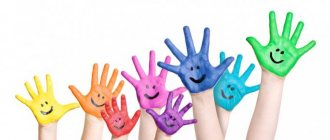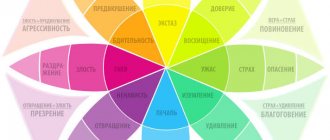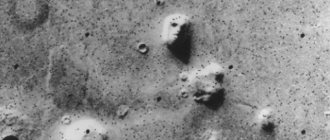Color is the area where our mind comes into contact with the Universe. Paul Klee
Our life is filled with color. Over the past hundred years the world has become brighter. The spectrum has not expanded, but the perception of color has changed.
The palette of ancient Greek painters consisted of only four colors (red, ocher, black and white). While the Renaissance era is, one might say, a “riot of color.” Venice, Paris and Amsterdam have fairly high humidity. This gives soft transitions of color tones - artists had to look for more and more new shades in order to convey all the beauty of the sky, sea, and landscapes. Today, thanks to the development of the chemical industry, we have not only the blue of the sky, the purple of the sunset and the green of the trees, but also colors created by man (neon, gold, etc.).
One thing is constant - color affects our mental and physical state. How? Find out from this article.
How the test works
To take the test, a series of colored cards are laid out in front of the test taker. The color scheme and display order must remain unchanged, otherwise the interpretation of the results will be incorrect. Next, the subject is given instructions for taking the test. He must take turns choosing the color he likes best. You can’t choose and think about cards for a long time. Having chosen the first color, you need to put the card aside and choose your new preferred color from the remaining ones.
You need to take the test until only one card remains. Next, the cards are collected again, shuffled and laid out in front of the subject. The selection procedure is repeated. All sequences of elections are recorded by a psychologist. The observer should also note the vivid emotional reactions of the subject that may accompany a particular color - this is necessary for the correct interpretation of the results.
Clinical Luscher color test
This test is called the complete Luscher test because... it contains more colors.
To carry it out, the following conditions are required:
- Good natural light.
- No direct sunlight.
- Using original colors (if you change the set of colors, the interpretation of the results will change)
This test is carried out like this:
- Choose from shades of gray.
- 8 colors.
- Choice of four primary colors.
- Among the blue.
- Among the green.
- Among the red.
- Among the yellow.
You can take the Luscher test here (including the full one) and here.
Choosing the right color
Sometimes subjects misunderstand the test conditions and choose not the color that they liked, but the one that they think is preferred by the psychologist. Sometimes they choose colors that are associated with their social image: women choose red, and men choose blue, even if they actually dislike it.
In such a situation, it is impossible to obtain correct test results. The subject must understand that he should be guided only by his preferences. He should not try to choose colors that the psychologist will like, ask clarifying questions, or try in any other way to figure out the “correct” sequence of colors. In this test, it is the personal choice of sequence that matters, which reveals the personality traits of the subject.
Application overview
iOS
Luscher test and personality psychology. Determining mood by color The appendix presents both short and full versions of the Luscher test.
Before starting testing, you need to enter your first and last name, read the instructions and select the type of test. The application is free. The results can be shared on social networks. Color test - psychological analysis of personality using the Luscher method
Dinis Ishmukhametov
Price: Free
Download
Price: Free
Meaning
The meaning of the key colors of the test can be determined using the psychological interpretation of colors: they correspond to personality traits. The meaning of the main colors of the Luscher test:
- Grey. A neutral color from a psychological point of view. It characterizes a person who seeks to hide, distance himself from others and limit his territory. Gray does not correspond to either bad or good character traits, but emphasizes reluctance to participate in the diagnosis. By choosing gray, a person can demonstrate his fatigue and apathy. Anyone who puts him in last place is often hyper-emotional and has inflated demands on himself and others.
- Blue. It symbolizes peace and contentment. This color is liked by people who are completely satisfied with their lives, do not experience stress, and easily find a common language with others. If blue is in last place, the person needs acceptance and a feeling of affection. He avoids communication with colleagues, constantly strives for new sensations, but does not receive satisfaction from them.
- Green. Those who choose green put health, willpower and self-affirmation first. Such people tend to consider any phenomenon from a logical perspective. They rely on their memory and analytical skills. Green in the last position means lack of faith in one’s own strengths, refusal of responsibility for one’s actions.
- Red. The color of vitality chosen by leaders. They strive to enjoy all aspects of life. They often have a wide circle of friends, but do not get close to people. Prone to manipulation and selfishness. Red in the last position speaks of a passive attitude towards life and a tendency to submit.
- Yellow. Choosing yellow in the first place speaks of a positive attitude towards life, calmness and love of change. Such people are friendly to others and are not prone to conflicts. They do not like tension and emotional unrest. Yellow in last place is an indicator of disappointment. A person feels isolated, deceived in his hopes. Therefore, he subconsciously avoids surprises so as not to receive new disappointments.
- Violet. This color forms a combination of red and blue - colors with opposite qualities. It is chosen by people with magical thinking, who tend to fantasize and dream of an ideal relationship. Teenagers often put purple first. Neglect of this color speaks of isolation and alienation, a rationalistic approach.
- Brown. People who need physical comfort tend to choose it. They value comfort and often need rest and a cozy home environment. If brown comes last, the person is rejecting his need for comfort. This can lead to loss of the capacity for pleasure and destructive compensation.
- Black. The color of complete negation. It is chosen by people who crave changes in their lives and refuse to put up with the reality around them. If black is in last place, the person is satisfied with living conditions or is afraid of change.
When interpreting the results, you need to take into account that all color methods give only an approximate result, which needs to be clarified using other methods.
Chaplin mask test
Another interesting test for schizophrenics is widely known in medical circles - the Chaplin test. This test was first introduced into use by psychiatrists by Richard Gregory, a famous scientist and professor of neuropsychology. The scientist, studying the difference between the existing reality in healthy and sick individuals, came to the conclusion that a person’s perception depends on thinking, which is based on existing experience.
Testing is based on optical illusion. The subject is asked to look at the rotating face of the legendary comedian for 2-3 minutes. And then tell me if there is anything strange in Chaplin’s moving appearance. Look:
If the person is healthy. A mentally adequate person, when faced with some new information, uses existing experience to process it. A healthy person experiences optical illusions when his already ingrained knowledge and experience about a certain subject does not correspond to the situation.
To people who do not suffer from a schizophrenic disorder, the face will appear convex and on the wrong side.
Initially, a person perceives an ordinary three-dimensional Chaplin mask. When the face rotates, a healthy person's visual system cannot perceive the inside of the mask as empty. Adequate people see another three-dimensional face there. This happens due to the following nuances:
- The brain of a healthy person does not quite adequately perceive the play of light/shadow on the inside of the mask.
- Human experience dictates to the brain knowledge of what appearance a face has. This is top-down knowledge.
- Dissonance occurs in the brain with the sensory signal.
- But in a healthy person, downward knowledge always has a clear advantage.
- The concave face on the reverse side of the mask of a healthy personality appears three-dimensional.
If a person is sick. One of the main symptoms of schizophrenia is a failure of all cognitive functions. Schizophrenics cannot perceive any optical illusions. A person suffering from schizophrenia will not find anything strange in a rotating mask. For a sick person, Chaplin's appearance will remain concave.
The reasons why individuals with schizophrenic disorder are unable to perceive optical illusions are not yet fully understood. There is a theory that such non-perception depends on the special manner in which sick people process visual information.
Comparison of the brain function of a healthy person and a patient with schizophrenia
If you can't see the 3D pinkish face on the back of the mask, rush to the doctors. But don't despair! Optical illusions are also not perceived by people under the influence of drugs, alcohol or severe stress.
Basic Rules
When taking the test, the subject must follow the rules so that the results obtained are as close as possible to his real experiences. The subject has the right:
- ask clarifying questions before starting the procedure;
- receive paper instructions that remain on the table while taking the test;
- refuse to undergo it if the technique causes him discomfort.
The subject is obliged:
- carefully follow the order of the test procedure;
- be as clear as possible when choosing your preferred colors;
- do not change the color choice after it has already been made.
The basic rule is that the subject must be in an adequate state, otherwise conducting a technique with the need to choose does not make sense.
CPD in the Ministry of Internal Affairs tests
For a comprehensive personality study, CPD tests are carried out at the Ministry of Internal Affairs. The research is carried out by specialist psychologists, who, after conducting it, give an opinion on the suitability of the candidate’s psychological abilities to occupy the position for which the candidate is applying.
TsPD in the Ministry of Internal Affairs tests are carried out with citizens wishing to join the service in the Ministry of Internal Affairs. The TsPD tests at the Ministry of Internal Affairs are the Short-term Orientation Test (SOT), and if necessary, when conducting the TsPT at the Ministry of Internal Affairs, the candidate may be provided with additional tests.
The Cat test online is a mathematical test that includes 50 questions that must be answered in 15 minutes. On our website you can practice taking the Cat test online without a time limit.
Blue color in psychology
Few people know that the influence of blue largely coincides with the influence of green on the human psyche. It can also induce relaxation and calm. The meaning of blue color in psychology has been studied quite well by experts. It has been experimentally established that blue and its shades must be used in rooms where there is intense movement of people or in cases where a person is forced to stay in the room for a long time.
In psychology, the color blue is calm and focused. And also appetite suppression, wisdom, truth, loyalty.
Unexpected results were obtained by scientists who tried to introduce blue color into people's surroundings. There is an experiment in psychology where blue lights burning on the streets at night significantly reduced the percentage of crimes committed in these places. And blue traffic lights on the railway reduce the number of accidents.
Using Color in Marketing
The fact that the importance of colors in psychology is great is evidenced by the fact that various commercial enterprises have made large investments in the study of this topic. Advertising products made taking into account existing research in the field of color psychology can significantly increase the profit of an enterprise.
The influence of colors on a person’s subconscious is so great that it forces him to perform certain actions or be passive. The color combinations used on signs, billboards of food service establishments or their production can make a person feel hungry. Consequently, there is a desire to purchase the advertised product.
Banks and service enterprises act in a similar way. The color shades on their signs should evoke a sense of trust and calm in a person. The emergence of client activity, a desire to use the company’s services - this can also be the result of the influence of the color of the advertisement.
(1 rating, average 5 out of 5)










